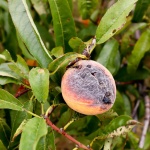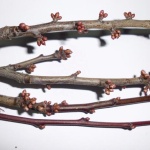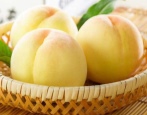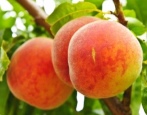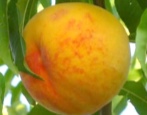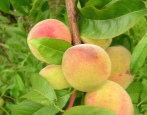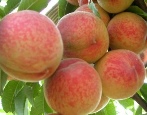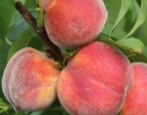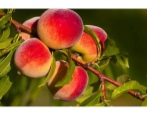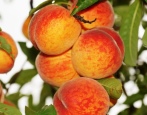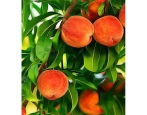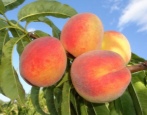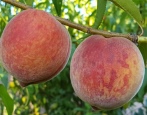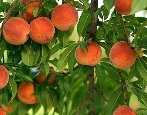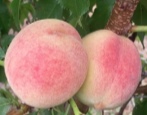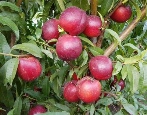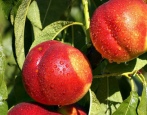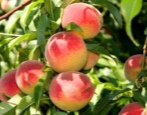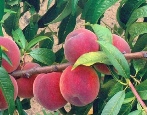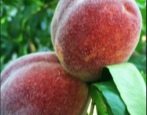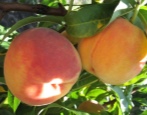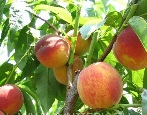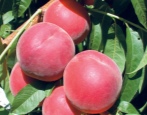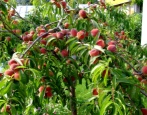
- Authors: Canada
- Appeared when crossing: Elberta early x Waikan
- Growth type: medium-sized
- Ripening period: average term
- Self-fertility: self-fertile
- Appointment: for fresh consumption
- Yield: high
- Transportability: good
- Early maturity: for the 3rd year
- Separability of the bone from the pulp: separates
Peach Veteran fully justifies its name, because it is already about 100 years old. However, the level of its demand does not decrease over the years, rather, on the contrary, it increases. The reason for this was the exceptional fruit characteristics, unpretentious care, reliable endurance properties and yield stability.
Breeding history
This old and time-tested culture appeared in Canada (Ontario) in 1925. Its “parents” were the peach varieties Elberta Early and Waikan. State tests of the culture have been carried out since 1948. It is recommended for cultivation within the North Caucasian region, but it is grown in other southern latitudes. The main direction of using the fruits is fresh consumption, although in fact they are closer to the universal peaches.
Description of the variety
Culture trees are medium-sized (up to 4 m), with spherical and dense crowns. Its popularity among gardeners is not diminishing, since it has a high level of endurance, optimal ripening times and great taste.
Of the pluses of culture, we also note:
obtaining stable and bountiful harvests;
a good degree of early maturity;
self-pollination productivity;
excellent parameters of keeping quality and transportability of peaches;
reliable level of resistance to clasterosporium and cytosporosis.
Minuses:
a relatively low level of immune potential for powdery mildew;
intense thickening in the crown area.
Fruit characteristics
Peaches are large (135-185 g), have a rounded shape. The peel is of bright yellow shades, with slight pubescence and with reddish highlights, occupying a significant part of its area. The pulp is not very dense, yellowish, juicy, with a pronounced aroma. The separation of the seeds from the pulp is satisfactory.
Taste qualities
The peaches are sweet on the palate, with an intense aroma.
Ripening and fruiting
Culture with medium ripening times. Most of the harvest is harvested in the second half of August. The degree of early maturity is good - in the third year of growth. Fruit bearing is annual, stable.
Yield
An average of 45-50 kg of peaches are removed from mature trees. A high degree of productivity is provided by the intensively occurring process of bud formation on trees.
Self-fertility and the need for pollinators
The plant is self-fertile - it does not need additional pollinators. However, yields can be increased by planting other peach varieties in the plots.
Growing and care
In temperate climates, it is more expedient to plant trees of culture in the spring. It makes sense to plant in autumn if the winter is in full accordance with the calendar parameters, and the temperatures do not drop below -15 ° С.
In other words, for productive rooting of trees, the temporary supply should be 8-10 weeks before the cold snap. In addition, in the autumn, the choice of young stock is wider, and the trees have foliage and developed roots, this allows for a high-quality and subject selection of seedlings.
Peaches are to be planted during dormancy. For the southern, northeastern and northwestern regions, we recommend the Veteran date for planting a peach on September 10-15. In the territories of Crimea and Krasnodar Territory, the culture is planted until October 20, but if a cold snap is predicted later, then until November 10.
In the Ural and Siberian regions, the culture does not have time to form ovaries and ripen, therefore it is grown exclusively in covered buildings.
Trees do not tolerate transplanting very well, for this reason, choosing sites for planting them should be thoughtful. The selected southern parts of the plots should not be shaded, but on the northern sides it is better to protect them with a fence (you can live), keeping a distance of 2 m. Lowlands are contraindicated for seedlings. The location of groundwater from the edge of the soil should not be less than 1.5 m.
We do not recommend planting seedlings after nightshade or melon crops. Rye and oats are suitable crop precursors.
More productive for the Veteran peach are sandy loam, loamy and chernozem soils, they have sufficient moisture and the necessary amount of lime.
By age, it is more expedient to select two-year-old seedlings (1.5 m in height, with 3-4 flowers). In general, the criteria for their selection and measures for the preservation of seedlings before planting are standard. The size of the planting depressions depends on the parameters of the seedlings, but they should not be less than 50x50x50 cm. Drainage of depressions up to 20 cm is desirable, but it is done according to the condition of the soil.
The crop planting algorithm is standard. The seedling is placed vertically, and the roots are spread along an earthen slide. The root collar is placed 3-5 cm above the ground level. Post-plant irrigation is carried out with 8-10 liters of water.
Spring feeding includes the introduction of nitrogen-containing fertilizers, while humus is also used. In the fall, the trees are fed with potassium-phosphorus supplements.
The procedure for molding pruning of the culture is carried out with the beginning of the budding process. In the autumn, during the harvest, sanitary cutting is performed.
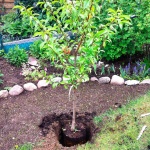
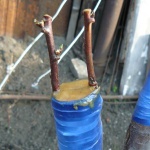
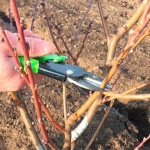
Frost resistance and the need for shelter
The degree of winter hardiness of the culture is assessed as high - the Veteran trees are hardy, but they will not withstand severe frosts. At temperatures of -20 ... 22 ° C, there is a risk of harm to the buds, flower ovaries and roots located in the upper layers of the soil.
This thermophilic crop, especially in areas with cool winters, should be sheltered. The critical temperature here is values below –20 ° С, which last longer than a month. For shelters, we use exclusively natural, "breathing" canvases (usually burlap), and next to it we organize an embankment of 30 cm in height. Shelters should be removed at a steady and stable temperature of + 5 ... 10 ° C.
The culture withstands dry times better than the cold - the plant is heat-resistant.
Disease and pest resistance
The high immune potential of the Veteran allows him to successfully resist clasterosporia, cytosporosis and other diseases. The level of resistance to powdery mildew is somewhat lower. Often, trees are attacked by aphids.Effective means "Inta-Vir" and "Iskra" are used against it, which, by the way, soon decompose. It is also useful to apply folk recipes for the fight against wrecking attacks, using infusions of wormwood, celandine and ash.
